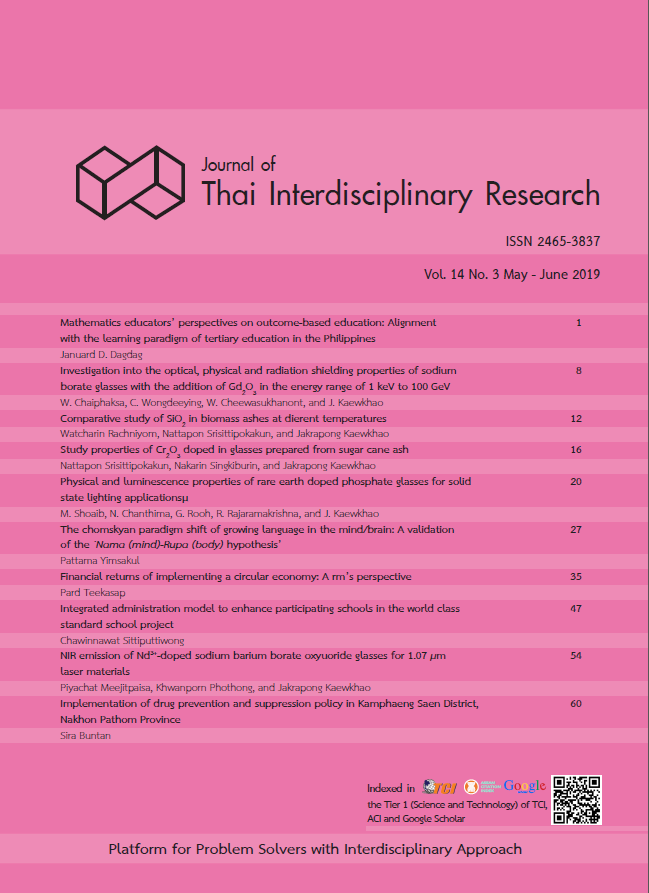Investigation into the optical, physical and radiation shielding properties of sodium borate glasses with the addition of Gd2O3 in the energy range of 1 keV to 100 GeV
Main Article Content
Abstract
This research studied the optical, physical and radiation shielding properties of glass samples produced using the melt quenching technique. Samples were prepared with diering concentrations of gadolinium sodium borate. The density of glass samples produced was measured using Archimedes’ principle. The optical properties and the hardness were measured using a UVspectrometer and a micro vickers hardness tester. The theoretical radiation shielding properties of glass samples were calculated using the WinXCom program in the energy range of 1 keV to 100 GeV. The results showed that the density, molar volume and hardness of glass samples was increased with concentration of Gd2O3 in the samples. The transmission all of the glass samples produced was found to be between 65% and 80%. From the calculations it was found that the mass attenuation coecients increased with increasing of Gd2O3 concentration and decreased with increasing energy. Photoelectric absorption was found to be the main interaction in the low energy range. At the medium energy range it was found that the radiation shielding parameters were almost constant and were dominated by Compton’s scattering process. In the high energy range it was found that pair production became the main interaction process.
Article Details
References
N. Chanthima, J. Kaewkhao, P. Limkitjaroenporn, S. Tuscharoen, S. Kothan, M. Tungjai, S. Kaewjaeng, S. Sarachai, P. Limsuwan. Development of BaO-ZnO-B2O3 glasses as a radiation shielding material, Radiat Phys Chemn. 137 (2017) 72-77.
L. Gerward, N. Guilbert, K. B. Jensen, Levring H. X-ray absorption in matter reengineering xcom, Radiat Phys Chemn. 60 (2001) 23-24.
U. Adem, D. Faruk, Determination of mass attenuation coefficients, effective atomic numbers and effective electron numbers for heavy-weight and normal-weight concretes, Appl Radiat Isotopes. 80 (2013) 73-77.
E. Kanal, Gadolinium based contrast agents (GBCA): Safety overview after 3 decades of clinical experience, Physica B. 34 (2016) 1341-1345.
J. Ramalho, M. Ramalho, M. AlObaidy, R. C. Semelka, Technical aspects of MRI signal change quantification after gadolinium-based contrast agents' administration, Physica B. 34 (2016) 1355-1358.
S. Kaewjang, U. Maghanemi, S. Kothana, H. J. Kim, P. Limkitjaroenporn, J. Kaewkhao, New gadolinium based glasses for gamma-rays shielding materials, Nucl Eng Des. 280 (2014) 21-26.
J. Rajagukguk, J. Kaewkhao, M. Djamala, M. Hidayat, R. Suprijadi, Y. Ruangtaweep, Structural and optical characteristics of Eu3+ ions in sodium-lead-zinc-lithium-borate glass system, J mol Struce. 1121 (2016) 180-187.
F. H. ElBatal, M. A. Ouis, UV-visible and infrared absorption spectroscopic studies of gamma irradiated tungsten- doped lithium phosphate glasses, Physica B. 406 (2011) 4175-4182.
P. Yasaka, N. Pattanaboonmee, H. J. Kim, P. Limkitjaroenporn, J. Kaewkhao, Gamma radiation shielding and optical properties measurements of zinc bismuth borate glasses, Ann Nucl Energy. 68 (2014) 4-9.
A. M. Shams, A. Kumar, M. I. Sayyed, M. G. Dong, Y. Elmahroug, Mechanical and gamma-ray shielding properties of TeO2-ZnO-NiO glasses, Radiat Phys Chemn. 212 (2018) 12-20.


